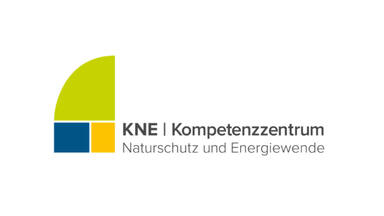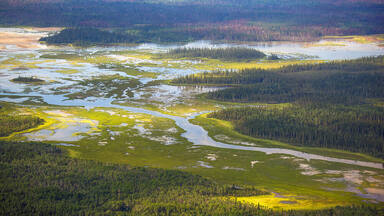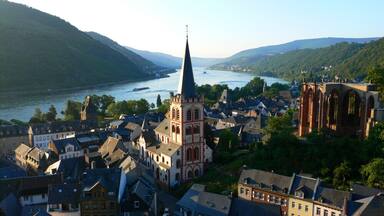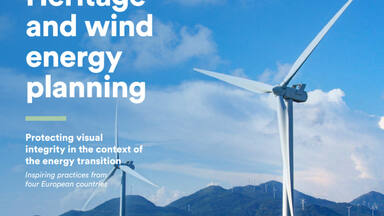The objective of the Guidance is to provide easy-to-understand and user-friendly information on wind energy projects and World Heritage protection and management, and to highlight processes and tools for overcoming potential challenges that may arise. The Guidance aims to assist in the planning of wind energy projects while providing insights to explore options for proactive conservation for World Heritage site managers and heritage protection authorities.The core of the Guidance includes four main parts
The Guidance is supplemented by a collection of Notes and Case Studies (provided by States Parties to the Convention). Furthermore, the Resources provide information on the sources which formed the basis for developing the Guidance and further literature, categorised by the main topics covered in the Guidance.
Users of the guide are invited to navigate it in a non-linear fashion, to search for information of particular interest to them and to click on the different icons that will provide them with additional information, cross-references (to other World Heritage resources), examples and case studies, as well as to specialized documents. The icons indicate the type of information they provide access to, or the audience the information is specifically aimed at (wind energy stakeholders and heritage stakeholders).
For technical terms used in this Guidance, please consult UNESCO’s World Heritage Glossary
Aknowledgements
Purpose and Scope
This Guidance aims at supporting States Parties to protect their World Heritage properties while pursuing their energy transition to renewable sources. Within the wide array of renewable energy sources, the Guidance focuses on wind energy projects, although many aspects of planning may, of course, be applied also to the development of other renewable energy sources, in particular photovoltaic energy projects.
As the number of wind energy project proposals will likely continue to increase in the coming years, the Guidance is targeted at those engaged in wind energy policy making, planning and development, but also at stakeholders involved in the protection of World Heritage properties, foremost site managers and national authorities, and furthermore at decision-makers in the project application process. Explanations are provided on World Heritage concepts and protection and management requirements as well as on processes related to wind energy development. The Guidance focuses especially on the intersection between the two areas. The Guidance thus informs and guides all stakeholder groups involved and seeks to encourage dialogue and communication, to enhance mutual understanding and to reach improved and constructive cooperation, which will result in the protection of World Heritage properties and wind energy projects that are developed in a “World Heritage compatible” way.
In an effort to safeguard World Heritage, the Guidance stresses the need to ensure wide cooperation between heritage and development authorities at the national, regional and local levels, and to include rights-holders and stakeholders from relevant sectors. This is fundamental to ensure the inclusion of World Heritage considerations in the early phases of wind energy planning to avoid irreversible negative impacts on the Outstanding Universal Value of World Heritage properties and consider alternatives from the outset. The Guidance also highlights the crucial role of impact assessments in this respect.
The Guidance focuses on wind energy deployment with specific reference to the Europe and North America region. This choice owes to the region-specific data and issues identified in discussions with States Parties, in state of conservation reports and in World Heritage Committee decisions. Indeed, States Parties in Europe and North America have explicitly expressed the need to receive guidance to better protect World Heritage properties in the current time of energy transition, considering management and conservation frameworks as well as impact assessments of wind energy facilities. Despite the focus on the Europe and North America region, the principles and the guidance provided, notably as regards the management and conservation of World Heritage properties, are relevant to all regions.
Context
Protection and management of World Heritage properties are guided by the World Heritage Convention text and its guiding documents, as well as by national legal frameworks. This can create challenges in designing and authorizing development projects, including wind energy projects within and around World Heritage properties. UNESCO’s endeavour to develop guidance focusing on wind energy projects started from the assumption that appropriate guidance could help avoid conflicting interest between the inevitable need for shifting energy production to renewable sources and protecting the Outstanding Universal Value (OUV) of cultural and natural World Heritage properties.
Climate Change as a defining topic of our time
Climate change is an urgent global challenge, the effects of which are increasingly felt at heritage sites and by communities all around the world. While the threat posed by climate change to natural and cultural World Heritage properties has been addressed by the World Heritage Committee for a long time, limited attention has been paid to the links between renewable energy projects – a strategy for societies to reduce their greenhouse gas emissions and mitigate climate change – and the protection and management of World Heritage properties.
Impacts of climate change on World Heritage
The IUCN World Heritage Outlook is the first global assessment of natural World Heritage, and since its launch in 2014, two subsequent reports were released in 2017 and 2020. The third IUCN World Heritage Outlook shows that climate change is the biggest threat to natural World Heritage, with a third of natural World Heritage properties threatened by climate change.
In 2014, an assessment by the Potsdam Institute for Climate Impact Research identified that more than 19% of cultural World Heritage properties will be directly affected by sea level rise in the long term.
In 2021, UNESCO, the Intergovernmental Panel on Climate Change (IPCC) and the International Council on Monuments and Sites (ICOMOS) organised a joint meeting to strengthen synergies between culture and climate science in the common fight against climate change, exploring linkages between culture and heritage, climate science and climate action.
ICOMOS International has also published a report in 2019 under topic Future of our Pasts: Engaging Cultural Heritage in Climate Action, outlining the links and potentials of heritage for climate actions. While this report encompasses cultural heritage as a whole, it puts an important emphasis on the role World Heritage properties could and should play.
Most recently, the Scientific Outcome of the International Co-Sponsored Meeting on Culture, Heritage, and Climate Change has been published as the result of collaboration between UNESCO and the International Council on Monuments and Sites (ICOMOS), co-sponsored by the Intergovernmental Panel on Climate Change (IPCC).
According to the 2021 report of the United Nations Intergovernmental Panel on Climate Change (IPCC), urgent and deep reduction of greenhouse gas emissions is needed to slow down climate change and maintain the health of the planet for current and future generations. Given that consumption of fossil fuels accounts for the majority of global anthropogenic greenhouse gas emissions, a transition to renewable energy sources is needed to meet society’s ever-growing energy demand. The energy transition is addressed in the United Nations 2030 Agenda for Sustainable Development whose goal 7 aims at ensuring access to affordable, reliable, sustainable, and modern energy for all. Goal 13 for Climate Action in turn urges global action to combat climate change and its impacts, including fast and intensive decarbonization efforts on a global scale. Faced with a climate emergency and to meet their growing energy demands, governments inevitably need to drastically cut their greenhouse gas emissions, including the use of fossil fuels and invest in cleaner energy production by increasing the capacity for renewable energy sources such as wind, solar, water, geothermal and bioenergy.
International climate commitments
Transformative actions are needed to limit global warming to 1.5 °C above pre-industrial levels in accordance with the 2015 Paris Agreement and to meet the objectives of the Glasgow Climate Pact and other commitments made under the United Nations Framework Convention on Climate Change (UNFCCC), and many countries have already expressed their commitment to become carbon neutral in the near future.
Main sources
- United Nations Framework Convention on Climate Change (UNFCCC)
https://unfccc.int/resource/docs/convkp/conveng.pdf
https://unfccc.int/resource/docs/convkp/kpeng.pdf - Paris Agreement and the outcomes from COP27
- UN 2030 Agenda and the Sustainable Development Goals
Over the years, the capacity of renewable energy installations has been constantly increasing. This has led to a diversification of the energy supply and has thus permitted to reduce dependency on fossil fuel markets, particularly oil and gas. Continuous technological developments in the renewable energy sector, particularly in the wind energy industry, have allowed for a faster deployment and the constant expansion of improved energy facilities. In the coming years the number of renewable energy facilities will continue to grow, as will this sector’s capacity. This development is likely to intensify the presence of renewable energy infrastructures, including wind farms, in many areas of the world. Indeed, these structures may increasingly become an integral part of our landscapes. It is therefore even more important to keep changes compatible with and sensitive to existing conditions and heritage values in an area.
Scenarios for wind energy developments until 2050
To better understand the potential development of the wind energy sector in the future, a number of national and international wind energy agencies, institutions and organizations have presented scenarios for different parts of the world, some of which are mentioned hereafter.
Similarly, the US Department of Energy has released its Wind Vision showing the projected growth of the wind industry up until 2050 and accompanied by a regularly updated roadmap of required actions.
The International Renewable Energy Agency (IRENA) has published the report FUTURE OF WIND: Deployment, investment, technology, grid integration and socio-economic aspects (2019) with a global outlook to the wind energy deployment up to 2050.
UNESCO as the United Nations Educational, Scientific and Cultural Organization, recognizing that the complexities of climate change require a holistic approach, aligned its UNESCO Strategy for Action on Climate Change (2018–2021 - ) with this notion. With the growing interest and support of its Members States, UNESCO’s programmes and actions strongly focus on climate change related issues, including actions under the World Heritage Convention.
World Heritage and Climate Change
Culture and heritage have a key role in understanding the causes and impacts of climate change and in designing responses, including low-carbon, climate- resilient pathways consistent with the aims of the 2015 Paris Agreement and other international agreements relevant to climate change. The design, conception, acceptability, feasibility and effectiveness of mitigation, adaptation, and measures to promote resilience measures are dependent on how well culture and heritage are understood and change across communities, regions and nation-states. The role of culture and heritage, including World Heritage sites, in addressing climate change is especially important within the context of human and ecosystem (including biodiversity) inter-connectedness; cities and urbanisation; land and water use and management practices and governance, including climate justice, capacity building, equity and wellbeing. Acknowledging and enhancing work that recognises the contributions of culture and heritage to understanding and responding to climate change is of critical importance to climate action efforts at all levels.
World Heritage properties account for less than 1% of the total Earth’s surface. These are sites of Outstanding Universal Value and are internationally recognized as being among the most significant cultural and natural heritage sites on our planet. Their protection is a shared commitment and declared priority for all States Parties to the World Heritage Convention, which need to ensure that effective and active measures are taken for the protection, conservation and presentation of the cultural and natural heritage.
In response to the recurring conservation threat posed by climate change to World Heritage properties a UNESCO Policy Document on the impacts of Climate Change on World Heritage properties has been developed and adopted in 2007.
Policy Document on the impacts of Climate Change on World Heritage properties
The policy document was adopted by the General Assembly of States Parties to the World Heritage Convention in 2007. In addition, the World Heritage Committee adopted the Strategy to Assist States Parties to the Convention to Implement Appropriate Management Responses in 2006 and the Strategy for Reducing Risks from Disasters at World Heritage Properties in 2007.
The policy document is currently being updated by the States Parties, in view of its adoption by the 24th session of the General Assembly of States Parties to the World Heritage Convention in 2023. There is a working draft of the updated policy document Policy Document on Climate Action for World Heritage, which provides high-level guidance on enhancing the protection and conservation of heritage of Outstanding Universal Value through the comprehensive adoption of climate action measures, including climate adaptation, mitigation, resilience building, innovation and research that promotes the co-benefits of climate action and heritage safeguarding by reducing real and perceived tensions between them.
Such frameworks would foster impact assessment tools, taxonomies and environmental and social standards that consider the cultural and social dimensions of climate action projects. They would further support proactive planning processes and methodologies that help avoid conflicts and also foresee conflict mediation.
Check for updates: https://whc.unesco.org/en/climatechange/
World Heritage properties play an important role in climate actions. Natural World Heritage properties and large cultural landscapes can help protect ecosystem integrity and functions and make a significant contribution to biodiversity conservation, which can provide significant co-benefits () for climate mitigation and climate adaptation (See for information this joint 2020 report of IPBES-IPCC). A 2021 UNESCO study found that forests in World Heritage sites play a vital role in mitigating climate change by absorbing 190 million tons of CO2 from the atmosphere each year. Another UNESCO study revealed that the 50 marine World Heritage sites host at least 21% of the world’s blue carbon ecosystem area, and 15% of the world’s blue carbon assets. The importance of ecosystem-based approaches or nature-based solutions is broadly acknowledged in policies in the fight against climate change. Cultural World Heritage can support decarbonization and combating climate change through the adaptive reuse of historic buildings. It also contributes through its role as a valuable source of knowledge and scientific information to inspire and inform environmental and climate change management and policies.
Thanks to their international recognition and prominence, World Heritage properties are prime places to carry out a number of functions in support of climate change action: they may serve as models of sustainable development and observatories to collect and share information on applied and tested monitoring, mitigation and adaptation practices. They may also showcase how societies can mitigate and adapt to climate change through an ecosystem and how they can convey traditional knowledge to support building resilience for changes ahead and a sustainable future.
No-go commitments
Threats to UNESCO World Heritage sites include also those arising from harmful industrial and infrastructure projects, extractive activities such as mining, oil and gas and large hydropower projects, among others. In view of these significant threats, several leading companies and financial institutions have committed to protect World Heritage by respecting them as ‘no-go’ areas.
- Following appeals by the World Heritage Committee to protect the Outstanding Universal Value of World Heritage properties, the International Council on Mining and Metals, and a number of other industry leaders have adopted a ‘no-go commitment’ not to explore or exploit for oil, gas or minerals in World Heritage properties, and ensure activities outside World Heritage properties do not negatively affect their OUV, considering that these activities in general are incompatible with World Heritage status.
- A similar no-go commitment has been issued by the International Hydropower Association concerning the construction of dams with large reservoirs, following the awareness raising activity of the World Heritage Committee and UNESCO.
Recently, UNESCO have launched a specific guidance for the World Heritage ‘No-Go’ Commitment
World Heritage properties and wind energy projects
In this time of climate crisis, the number of renewable energy projects, and among them wind energy projects, will likely increase. Nevertheless, all parties concerned should keep in mind that the characteristics of values – and therefore also of the Outstanding Universal Value of each World Heritage property – are unique and diverse. Renewable energy projects need cautious and adequate planning and implementation to avoid negative impacts on the authenticity and integrity of World Heritage properties and their Outstanding Universal Value. For this reason, the impact of wind energy installations on the OUV of World Heritage properties should be assessed case-by-case. For some properties, even a single wind turbine may present a threat, for other properties the installation of a wind farm within the wider setting may be possible if planned and designed outside the property’s boundaries and with due respect for its protection and management needs.
To this end, the provisions of the World Heritage Convention and the Operational Guidelines for the Implementation of the World Heritage Convention request States Parties ‘to ensure that effective and active measures are taken for the protection, conservation and presentation of the cultural and natural heritage situated on’ (Convention text Article 5.) their territory. States Parties are further requested to ensure that appropriate impact assessments are being carried out as a pre-requisite for development projects that are planned for implementation within or around a World Heritage property (OG 118.bis) and are invited to inform the World Heritage Committee, through UNESCO, of their intention to undertake or to authorize in an area protected under the Convention projects, which may affect the Outstanding Universal Value of a World Heritage property(OG 172). In addition, States Parties and other stakeholders need to ensure overall sustainability of the renewable energy projects, in accordance with the sustainable development principles, in line with the UNESCO Policy on the integration of a sustainable development perspective into the processes of the World Heritage Convention.
Policy on the integration of a sustainable development perspective into the processes of the World Heritage Convention
This policy document was adopted by the General Assembly of States Parties to the World Heritage Convention in 2015. It aims at guiding the States Parties and other stakeholders so that World Heritage processes can actively contribute to the United Nations 2030 Agenda for Sustainable Development and to increase the effectiveness and relevance of the Convention in this regard whilst respecting its primary purpose and mandate of protecting the Outstanding Universal Value of World Heritage properties.
By identifying, protecting, conserving, presenting, and transmitting to present and future generations irreplaceable cultural and natural heritage properties of Outstanding Universal Value, the World Heritage Convention, in itself, contributes significantly to sustainable development and the wellbeing of people. In implementing the Convention, States Parties should consider the three dimensions of sustainable development, namely environmental sustainability, inclusive social development, and inclusive economic development, together with the fostering of peace and security, which should apply to all natural, cultural, and mixed World Heritage properties in their diversity. In addition, they should avoid, and if not possible mitigate, all negative impacts on the environment and cultural diversity when conserving and managing World Heritage properties and their wider settings. States Parties should also keep in mind that these dimensions are interdependent and mutually reinforcing. Therefore, no individual dimension should have priority and they cannot be offset against a World Heritage context.
States Parties should also recognise and promote the World Heritage properties' inherent potential to contribute to all dimensions of sustainable development and work to harness the collective benefits for society, also by ensuring that their conservation and management strategies are aligned with broader sustainable development objectives. In this process, the properties’ OUV should not be compromised.
This Guidance was born out of the will to encourage the States Parties to the World Heritage Convention, the sectors of World Heritage conservation and wind energy development to join forces and take proactive actions by establishing effective legal, regulatory, and institutional mechanisms, and conducting responsible project planning in order to guarantee that the shift to renewable energy production goes hand in hand with the long-term protection of World Heritage properties.
Notes
The objective of these notes is to provide supplementary information for certain aspects of Guidance. However, they do not provide exhaustive and complete information in their respective topic.
- Note 1 – Identifying and mapping attributes that convey the Outstanding Universal Value of a World Heritage property
- Note 2 – Identifying sensitive areas and preparing vulnerability assessment related to wind energy projects
- Note 3 – Identification of rights-holders and other stakeholders, and engagement tools
- Note 4 – Guiding questions to identify the characteristics of impacts related to wind energy projects
- Note 5 – Visual Impact Assessment
- Note 6 – Cumulative impacts
Case Studies
received from States Parties
The case studies that are referenced in relevant parts of the Guidance, are contributions from respective States Parties to the Convention, providing insight to planning and implementing wind energy projects which relate to World Heritage properties.
The information and approach included in the case studies do not necessarily reflect the views and standpoints of UNESCO. UNESCO does not warrant that the information contained in these case studies are complete and correct and shall not be liable whatsoever for any damages incurred as a result of their use.
The World Heritage Centre wishes to leave open the possibility for States Parties to provide further relevant case studies, which is possible by submitting a request to the following email address: wh.eur@unesco.org
- Assessment of cumulative impacts of multiple developments near a World Heritage property in Canada
- Policy framework for a controlled wind energy development near a transboundary World Heritage property (Denmark, Germany, the Netherlands)
- Planning offshore wind turbines along the coast of Normandy, France
- Strategic planning of wind energy projects outside a World Heritage property and its buffer zone in the Upper Middle Rhine Valley in Germany
- Impact assessment of a wind energy development project near a World Heritage property in the Netherlands
- Stakeholder participation and engagement – a discussion forum to develop joint recommendations, the example of the KNE Dialogue (Germany)
Resources
World Heritage
Convention Concerning the Protection of the World Cultural and Natural Heritage. 1972.
Operational Guidelines for the Implementation of the World Heritage Convention
World Heritage POLICY COMPENDIUM
Managing Cultural World Heritage. UNESCO et al. 2013.
Managing Natural World Heritage. UNESCO et al. 2011.
Preparing World Heritage Nominations, World Heritage Resource Manual. UNESCO et al. 2011.
Guidance on Developing and Revising World Heritage Tentative Lists. UNESCO et al. 2020.
The Nara Document on Authenticity. ICOMOS. 1994.
Document of the International World Heritage Expert Meeting on Visual Integrity Agra, India. 2013.
World Heritage and Renewable Energy/Wind Energy
GOOD PRACTICES: success stories on sustainable and renewable energies in UNESCO Sites. UNESCO. 2013.
Climate Change and World Heritage
Climate Change and World Heritage
Policy Document on the impacts of climate change on World Heritage properties. 2021.
World Heritage Outlook 3. IUCN. 2020.
Future of Our Pasts: Engaging Cultural Heritage in Climate Action. ICOMOS. 2019.
Sustainable Development
The 2030 Agenda for Sustainable Development adopted by all United Nations Member States in 2015
World Heritage and Sustainable Development
Impact assessment for World Heritage properties
Guidance and Toolkit for Impact Assessment in a World Heritage context. 2022
Impact Assessment for World Heritage II – steps and processes. Webinar. ICCROM, IUCN, ICOMOS 2020.
Mitigating biodiversity impacts associated with solar and wind energy development
The publications of the International Association for Impact Assessment (IAIA) might also serve as useful sources of updated general information related to the complex aspects of impact assessment.
https://www.iaia.org/publications.php
Rights-holders, stakeholders and participation
World Heritage and Indigenous Peoples
UNESCO policy on engaging with indigenous peoples. 2018.
People-Centred Approaches. ICCROM.
People-Centred Approaches to Conservation of Cultural Heritage: Living Heritage. ICCROM. 2011.
World Heritage and Rights-Based Approaches. ICOMOS Norway, ICOMOS, IUCN and ICCROM. 2014.
World Heritage and Rights-Based Approaches. ICOMOS Norway.
Rights-based approaches to conservation. IUCN.
Our Common Dignity Initiative. ICOMOS.
Environmental and social framework. The World Bank. 2017.
Other sources for developing the guidance tool:
Long-term decarbonization strategy. European Commission. 2020.
Impact Assessment 2020. European Commission. 2020.
Wind Energy. European Commission.
Wind Energy Facts. European Commission.
National renewable energy action plans 2020 in the European Union. European Union.
Wind energy in Europe 2020 Statistics and the outlook for 2021-2025. Wind Europe.
Global trends in renewable energy investments 2020. Frankfurt School-UNEP Centre, BNEF. 2020..
World Energy Outlook. IRENA. 2020.
Renewable energy Statistics 2020. IRENA. 2020.
Social Impact Assessment (SIA). International Institute for Sustainable Development. 2016.
The Renewable Energy Landscape: Preserving Scenic Values in our Sustainable Future. Apostol et al. (eds) 2016. Routledge.
An open source GIS tool to quantify the visual impact of wind turbines and photovoltaic panels
Minelli et al. 2014. Environmental Impact Assessment Review Volume 49, November 2014, pp. 70–78.











